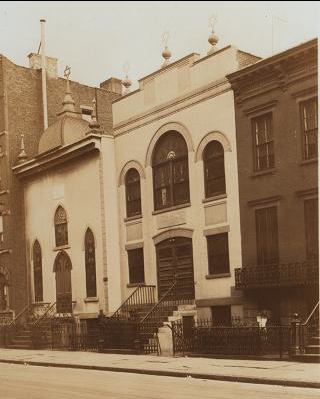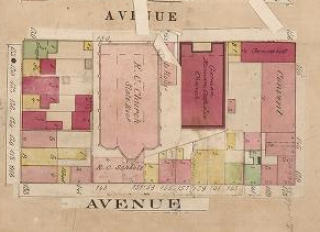[Editor's note: This article was originally written circa 2010, but was never published. It has been lightly edited and updated for publication now.]
Brooklyn is called the borough of churches, and in the 19th century, it seems that Brooklyn was also a big game of musical churches. Congregations would start up, grow quickly, and then split up or just plain disappear. Often the splits were the result of doctrinal disagreements among congregants or between congregants and their pastor. It was not uncommon for half a congregation to walk away from their church and establish a new church a few blocks away. Other times, demographics would lead to changes in congregations. As one result of all this factional tumult, church buildings would frequently change hands, being passed from denomination to denomination or among congregants of the same denomination.
One example of this is the former Temple Beth-El Synagogue at 108 Nobel Street - the building with Gothic arches, to the left in the 1936 photo. The building to the right in this photo (with double-height rounded arches) is the synagogue of Congregation Ahavas Israel, constructed in 1904. Today, both buildings are owned by the Greenpoint Shul. While the brick structure at 108 Noble is more imposing, it is 110 Noble that has always intrigued me more. Despite the faux facades (permastone on the front, asphalt shingles on the rear - a Greenpoint exacta), it is clear from a glance that this is a very old building, one that probably was not constructed as a synagogue. How this building came to be a synagogue, and how two synagogues wound up adjacent to one another, is a particularly Brooklyn tale of musical churches.
The Universalist Church of the Reconciliation
Sure enough, some quick map research showed this to be a former Universalist Church, dating to sometime before 1868 (the first map on which the building appears). According to accounts in the Brooklyn Daily Eagle, the wood-frame church at 110 Noble Street was constructed by the Universalist Church of the Reconciliation in 1862 (the Landmarks Commission says 1863). The Universalist Church of the Reconciliation was founded in 1857, and by the 1880s, it had outgrown their Nobel Street church and the congregation was looking for a more substantial structure. And that is where this particular game of musical churches begins.
In April of 1887, the Universalists sold their church building to Temple Beth-El, a newly-formed reform Jewish congregation, for $5,000.1 The Universalists continued to hold services in the Noble Street church until May of that year, at which time the property was turned over to Temple Beth-El.2 For the next three years or so, the Universalists held services in temporary quarters (including an armory on Calyer Street just east of Clifford Place) until they were able to build a new church on North Henry Street.
Although the Universalists sold the Noble Street church in order to secure a newer masonry structure, the church they ended up constructing on North Henry Street in 1890 was also a wood-frame structure. The architect for the new North Henry Street church is listed as John C. Snakenburg3, who was probably the same John C. Snackenburg who appeared in the 1897 city directory as an “expert inspector” living at 175 Java Street. 4
By 1924, Third Universalist/Church of the Reconciliation has disappeared from the public record. In the Brooklyn red book directory of that year, the North Henry Street church was occupied by a Disciples of Christ congregation as the Winthrop Park Church (Winthrop Park being the former name of nearby Monsignor McGolrick Park). The building is still used as a church, and now houses the Church of Christ at Greenpoint. More musical churches.
Ahavas Israel and Temple Beth-El of Greenpoint
According to the Brooklyn Citizen Almanac, Temple Beth-El was founded in 1886. It is believed to be the first Jewish congregation in the 17th Ward (as Greenpoint was also known then). Before it found a permanent home at 110 Noble Street, the congregation held services in the Calyer Street armory, and, for a brief time, in the old Germania Hall on Franklin Street.5 During the summer of 1887, the congregation spent $1,500 to renovate the former church on Noble Street and convert it into a synagogue. Rabbi A. Wohlkuhn was named as the congregations first rabbi in August of 1887.6 Temple Beth-El held its first services on Rosh Hashanah, in September of 1887.7 Both 108 and 110 Noble Street are now owned by Congregation Ahavas Israel. According to it’s website, Ahavas Israel was founded in 1893 as an orthodox congregation, and merged with the reform Temple Beth-El in 1898. The website says that the joint congregation built the “West Building” (108 Noble) together in 1903.
The Jewish Communal Register of 1917 says that the joint congregation was formed in 19038, which is also the earliest date that Ahavas Israel appears in lists of Brooklyn congregations. It was not included in a comprehensive listing of Jewish organizations in the American Jewish Yearbook of 5661 (1900 - 1901). A 1904 article in the Menorah says that Congregation Ahavas Israel, the Congregation of United Brothers and the Congregation of the Relief of Israel, all of Brooklyn, have merged and will be called Congregation Ahavas Israel (but interestingly, does not mention Beth-El).9 To make matters more confusing, it appears that Temple Beth-El was still active as a separate entity into the 1930s, when the photo above was taken (the last obituary for a congregant in the Times dates to 1935, but the congregation could well have survived beyond that).
The earliest public mention of Ahavas Israel comes in connection with the sale of the former Union Avenue Baptist Church at 705 Manhattan (formerly Union) Avenue. In 1900, Union Avenue Baptist Church and the First Baptist Church of Greenpoint (a.k.a. the Noble Street Baptist Church) merged, taking up residence in First Baptist’s 1863 church building on Noble Street (just up the block from the current Ahavas Israel). As a result, the former Union Avenue Baptist Church became surplus property and was put up for sale in 1900.10 In May, 1902 the Brooklyn Daily Eagle reported that Temple Beth-El, looking to upgrade its facilities, was interested in buying the Union Avenue church but lost out to "several well known Manhattan avenue business men" who acquired the building for $13,500.11 But in February of the following year, a New York Times article reported that the former Union Avenue Baptist Church was being sold by Temple Beth-El for use as a market. Based on the Times article, it appears that the Manhattan Avenue property had been acquired by Temple Beth-El after all, following “a hard contest last Summer” between Greenpoint’s orthodox (Ahavas Israel) and reform (Beth-El) Jews over the property. The two congregations had bid against each other, with Temple Beth-El eventually winning the property with a $13,500 bid. After being outbid by their “brethren... the orthodox Jews [of Ahavas Israel] went to work and purchased a private dwelling adjoining the Temple Beth-El in Noble Street... where the reformed Jews worship.”12
Ahavas Israel (surely the orthodox congregation referred to in the 1903 Times article) used the Noble Street house for its services for a brief period. But by 1904, they had developed plans to build a new synagogue on the site. The permit for the new building is recorded in the Real Estate Record and Builders Guide in July of 1904, with E. D. Hamlin listed as the architect.13
In August of 1904, the Times reported that the cornerstone for “the first orthodox synagogue in the Greenpoint section of Brooklyn” was laid (the cornerstone itself confirms this date, although the Ahavas Israel website says 1903). According to the Times, there were over 1,200 “Orthodox Hebrews” in Greenpoint at that date, and with no synagogue to worship in, Ahavas Israel had been holding services “in a hall hired by members of the congregation” (probably on Manhattan Avenue near Milton Street).14 The Record and Guide reports that the brick structure cost $10,000.
It is not clear why Temple Beth-El never occupied the former Baptist church on Manhattan Avenue. In 1905, the former Union Avenue Baptist Church was occupied by the Greenpoint YMCA (now on Meserole Street). The building was demolished in 1914 to make way for the Greenpoint Post Office.15 Today, the nondescript two-story stucco structure houses the Imperial Palace restaurant/catering hall and a number of ground-floor retail establishments.
- 1“Congregation Beth-El’s New Church,” Brooklyn Daily Eagle, April 30, 1887, 1.
- 2“Congregation Beth El,” Brooklyn Daily Eagle, May 18, 1887, 5. “Church of the Reconciliation: Its Closing Services in the Noble Street Edifice,” Brooklyn Daily Eagle, April 23, 1887, 2.
- 3“A New Church Edifice: For the Universalist Society of the Seventeenth Ward,” Brooklyn Daily Eagle, September 7, 1889, 1.
- 4The directory also lists a “John Snakenburg”, who was a notions dealer at 1855 Broadway.
- 5“Congregation Beth-El,” Brooklyn Daily Eagle, September 24, 1885, 5.
- 6“Rabbi A. Wohlkuhn Chosen,” Brooklyn Daily Eagle, July 23, 1887, 4.
- 7“Services in the New Temple,” Brooklyn Daily Eagle, September 22, 1887, 4.
- 8Samuel Margoshes, The Jewish Communal Register of NYC, 1917-1918, pg. 256
- 9The Menorah (volume 36, January, 1904), p. 311
- 10The church (at what is now 740 Manhattan Avenue) was demolished in 1914 to make way for the new Greenpoint Post Office. Today there is a catering hall at that location.
- 11"Union Avenue Church Sold", Brooklyn Daily Eagle, May 21, 1902, 22.
- 12"To Turn Church Into Market", New York Times, February 15 1903, 24.
- 13Real Estate Record and Builders Guide (July 9, 1904), pg. . The congregation is listed as "Congregation Israel, 184 Franklin Street. The builder is listed as W. G. Miller, who had offices at 16 Bedford Avenue. The Hamlin listed here is a mystery. The Real Estate Record lists his address as 128 Java Street, but there is no record of a Hamlin on Java Street in the 1897 directory nor in the 1900 census. There is a Hamlin family on Kent Avenue, but no one there with the first initial “E”. The 1900 census does include an E. P. Hamlin (who turns out to be Edwin P.) living with his brother Frederick on Putnam Avenue. E. P. Hamlin’s occupation is listed as draughtsman, so it is very possible that he is the Hamlin responsible for Ahavas Israel. Unfortunately, after the 1900 census, E. P. Hamlin disappears from the historic record as well. (The search for Hamlins in the architecture field is not made any easier by the fact that A. D. F. Hamlin was a very prominent professor of architecture at Columbia University at this time, and his son, Talbot, was to be even more prominent in the field. To make matters worse, these Hamlins are likely related to both George Hamlin (of Kent Street) and Frederick and Edwin of Putnam Avenue.)
- 14"Synagogue Cornerstone Laid," New York Times, August 8, 1904, 14.
- 15Eugene Arbruster, Brooklyn's Eastern District (Brooklyn, 1942), p. 222

